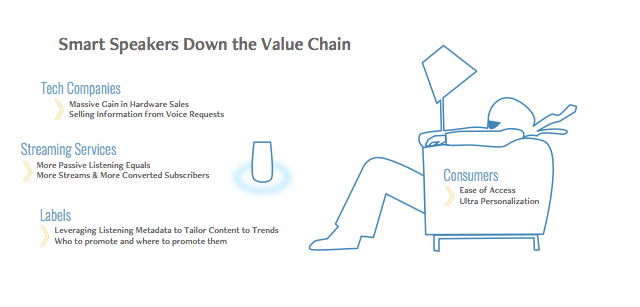OnPrem is now Qvest! Providing technology and business solutions across five continents, we are proud to be the world’s largest media and entertainment focussed consulting firm.
Forget about virtual reality and wearables. These buzzy technologies pale in comparison to the market for smart speakers. Global technology research firm Canalys started 2018 by calling it “the defining year for smart speaker adoption,” noting that the pressure was on to “monetize the growing installed base in the U.S. and beyond.”[1] Indeed, by Q3 2018, smart speaker shipments had grown 137% over 2017, with a forecast of 75 million for the year.[2] In fact, 2018 ultimately saw 86.2 million speakers shipped.[3]
The swift upward trajectory of intelligent, voice-enabled speakers is altering the music-streaming world dramatically, affecting the way consumers interact with technologies. According to a recent report from NPR and Edison Research, 60% of smart speaker owners regularly use their devices to play music.[4] As algorithms become increasingly more sophisticated, capable of catering to multiple device users (and voices) individually, even traditionally passive listeners are swapping old radio habits for paid subscriptions to streaming music services.
For hardware companies like Google and Amazon, the benefits of the smart speaker boom are pretty straightforward: enormous sales. But labels, artists, and streaming music companies also stand to gain if they adapt smartly to the change, specifically in terms of how they apply and use metadata. That includes tagging tracks with basic information such as the artist name, song name, and album name, but also the “soft categories” like genre, mood, and style. After all, if you don’t know whether a song is “happy” or sad,” whether it’s “hippie”or “conservative,” whether it’s “good for working out” or “good for making out,” you can’t properly target it.
Companies that take the initiative to create robust strategies around their metadata management (MDM) will have a distinct advantage, from their customer experience to their revenue streams. Those that don’t won’t just miss out on the benefits of MDM; they’ll quickly become irrelevant.
Shifting habits, emerging opportunities
Smart speakers owners aren’t just listening to music. They’re listening to a lot of music. In fact, 34% of them spend more than four hours a day listening — compared to 24% of the general population. Nearly half of them subscribe to a music-streaming service[5], and 71% have increased their listening habits since they started using smart speakers.[6]

By tapping into consumer behavior data around smart speaker queries, hardware companies can better understand consumer engagement and possibly inform artists and labels which artists and songs to promote, and when and where to promote them. There’s valuable information inherent in this user data. For instance, Spotify has found that smart speaker users are more likely to listen to music on weekends than other customers — and more likely to request nostalgic songs.[7]
More music through more channels also means more “in the moment” sales opportunities for artists and labels, including merchandise, concert tickets, vinyl, and more. We’re not far off from the day our smart speaker will queue up concert tickets to a band we’re enjoying in the moment, helping us buy them instantly without ever touching a screen.
And for streaming music services themselves, the advertising opportunities are bountiful thanks to robust algorithms that take consumer-activated voice queries and process them into highly customized ad programming. Over time, smart speakers give advertisers the ability to scope targeted ads to a preferred customer base. In fact, it’s already been proven that passive smart speaker listeners tend to stay put through ads that phone or computer users, with device in hand, might skip.[8] Labels have also begun to develop agreements with search companies to associate keyword searches to featured artists in scenarios when a new album is released, etc to drive awareness and monetization.
The massive music metadata movement
With all of the influence smart speakers and their owners hold over music right now, technology and the music industry are coming together to create joint products and new standards for music metadata. It’s an exciting time for music technology that of course brings plenty of risk for the various stakeholders.
Labels and publishers defining the future of music are challenged to establish thoughtful processes to best assign metadata to music files, with strict governance over the processes. The ideal would be wide adoption of an established or enhanced industry standard for music metadata so it could be uniformly recognized across platforms and environments. Failing to put a uniform system in place for metadata standards would increase the risk of fragmentation within the industry, increasing the cost of adoption down the road.
One of the regarded flaws of streaming platforms is their tendency to favor a very small percentage of popular artists who get the benefits of search optimization and playlist placement. As consumption continues to shift to voice search, labels could have an increasingly hard time breaking new artists. It’s not inconceivable that voice search optimization could become yet another way for technology companies to extract “rent” from labels.
The data coming out of tech companies is already a black box (as evidenced by lawsuits against DSPs for royalty payments and the recent charges of fraud by TIDAL). Without insight or control of metadata and the way it’s used by smart device manufacturers and software providers, labels, publishers, and artists would lose control of even more of the process.
It’s time to define your metadata
With machine learning rapidly advancing and smart speaker sales in no danger of slowing, metadata is quickly becoming the foundation of the music industry. To see powerful and valuable results from both the data inherent in music files and the user data its play produces, every music-industry company that operates must have a credible, well-thought-out MDM plan in place and a stake in evolving industry standards. Fail to take initiative, and a company will miss out on the full extent of the opportunities inherent in music today.
Now is the time to define your metadata
Here are the questions any company or organization operating within the music industry should be asking:
- What are the necessary values to capture at every level of a music asset in order to promote better user experiences during streaming?
- What data does a company then need to capture back about a user’s listening preferences in order to better tailor those experiences?
- How can you ensure that every relevant department within your organization is included in the process of data identification and alignment, so things like governance structures and naming conventions are standardized company (and even industry) wide?
[1] https://www.canalys.com/newsroom/smart-speakers-are-fastest-growing-consumer-tech-shipments-surpass-50-million-2018
[2] https://www.canalys.com/static/press_release/2018/Press-Release-151118-Global-smart-speakers.pdf
[3] https://musically.com/2019/02/20/report-smart-speaker-shipments-grew-to-86-2m-units-in-2018/
[4] https://www.nationalpublicmedia.com/smart-audio-report/latest-report/
[5] https://musically.com/2018/03/21/smart-speakers-impact-music/
[6] https://www.nationalpublicmedia.com/smart-audio-report/latest-report/
[7] https://www.recode.net/2018/11/12/17765390/voice-alexa-siri-assistant-amazon-echo-google-assistant
[8] https://www.recode.net/2018/11/12/17765390/voice-alexa-siri-assistant-amazon-echo-google-assistant
